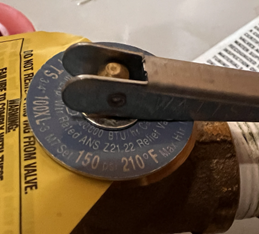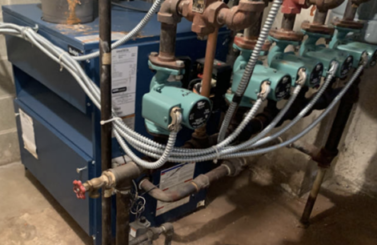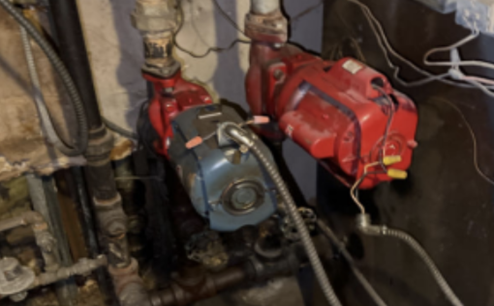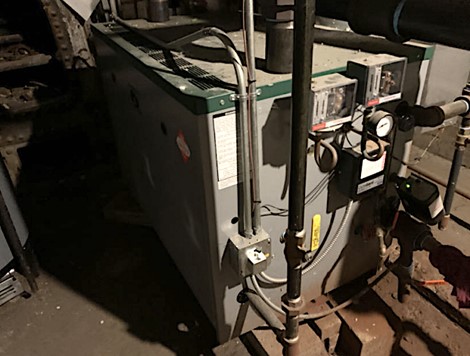There are two different types of boilers found in commercial buildings: hot water and steam boilers. There are similarities between the two types of boilers, and differences as well.
Both types of boilers have a fuel source. This could be natural gas, propane, fuel oil, or electricity. There are some that use solid fuel, like wood, pellets, or coal. The most common fuel is natural gas.
Both types of boilers are connected to a water source. The water source is typically high-pressure, ranging from 30 to 80 psi. A hot water system operates at a relatively low pressure of 10 to 15 psi. A steam boiler operates at a very low pressure of 2 to 4 psi. Steam travels best at low pressures, whereas hot water is driven by a pump.
Regardless of the type of system, a pressure-reducing valve should be installed at the main water inlet. This valve reduces the incoming water pressure from the service down to the usable pressure needed for the system to operate. The pressure-reducing valve in conjunction with the main water valve are the first two safety devices installed on a boiler.
Hot Water Boilers

Hot water boiler
Water is supplied to the heat exchanger, which is located on the interior of the cabinet. This heat exchanger is like a kettle on a stove. As the water heats up, it expands. A hot water system is designed to take this heated water and distribute it through a building. This distribution is performed by a mechanical pump. The water in a hot water system should never reach a temperature of 212° F, which is the boiling point (at sea level).
If the water was allowed to boil, then the hot water system would be a steam system. In order to prevent boiling, the heated water needs to have a place to expand. This process happens in the expansion tank. The expansion tank is the second safety device in a hot water system. There should also be a high-temperature limit switch installed. This would turn off the gas supply or eliminate the heat to prevent the water from boiling.

Water heater
The hot water boiler should also have a temperature-pressure relief valve installed. This safety valve is designed to have a maximum pressure of 30 psi. At 30 psi, the valve will open and relieve the pressure from the system. This valve should have an extension pipe that evacuates the expelled water to within 6 inches of the floor. It is very important to verify the rating on the relief valve because it is a different valve than another valve that might be installed on a steam system, or even on a water heater.
A thermostat or control module calls for a pump to circulate water through the system. This pump will move water past an operating switch. This switch is also called an aquastat. This switch controls the operation of the burners and the rate of the burners according to how much heat is needed. Basically, it turns on and off, depending on the demand.
There is no standard temperature of water supplied by a hot water boiler. This temperature is set by the type of radiator in use, the distance needed to supply the water, the type and efficiency of the boiler, and many other factors. Typically, an engineer or technician sets the temperature. There should be a gauge on the side of the unit. This gauge measures the temperature the water is to be set at, the actual temperature, and the pressure of the system. This gauge is called a tridicator.
There are two types of pumps used on hot water systems. One is a closed pump. This type of pump does not require any maintenance. The other type is a three-piece pump. Many refer to this type as a Bell and Gossett, the manufacturer. This pump has a motor, a bearing, and a pump. Each of these three elements requires lubrication and maintenance. This type of pump is also more expensive than a closed or one-piece pump. Using multiple pumps on one boiler allows for multiple zones of distribution.
Use the Hot Water Boiler Inspection Checklist if a hot water boiler is present at an inspection.


Steam Boilers
Steam boilers work by the same general principles as a hot water system except that instead of just heating the water, the system is designed to boil the water. The resulting steam is then distributed through the pipes and into the various radiators throughout the property.

Pressuretrol
The steam boiler has a temperature-pressure relief valve. This is a safety valve that will operate at very low pressure, even lower than a hot water unit at 30 psi. This unit will also have a sight glass. This is a clear tube mounted on the side of the unit that indicates the amount of water that is in the heat exchanger. This sight glass is most likely the first indication of the unit being a steam system and not a hot water boiler.
A hot water boiler has a low-water cutoff switch that will shut down the unit if there is a lack of water. A steam system has a Hartford Loop to protect the boiler from running out of water.

Steam boiler
A steam system operates at low pressure and without a pump. The steam moves very effectively through a pipe at low pressure and will rise through the building on its own. There should be a pressure gauge and pressuretrol. This is usually found with a coiled copper tube or pigtail on it. This sets the pressure on the system and acts as a high-limit control or safety device.
The boiler will create steam. This steam rises from the boiler through the main pipe and into a radiator. The radiator traps the steam and gives off heat. As the heat is given off, the steam condenses back into a liquid, and the liquid travels out of the radiator and back to the boiler through a return pipe, where it is reheated. This type of system is a closed-loop system.
Use the Steam Boiler Inspection Checklist if a steam boiler is present at an inspection.
Operation and Inspection
The operation and inspection of either a hot water or steam boiler should include the visual identification of the components, as well as activation of the thermostat to visually identify any issues during operation. During the heating season, these units will typically be in operation and will not require exercising thermostats. Any units found in a “shut-down” or “off” position should not be operationally tested.
The distribution inspection involves verifying that there is warmth or heat present at the radiators, and that the system is free of leaks. Only readily accessible units can be verified.
Article Written By: Rob Claus, CMI®
Additional Commercial Property Inspector Resources:


